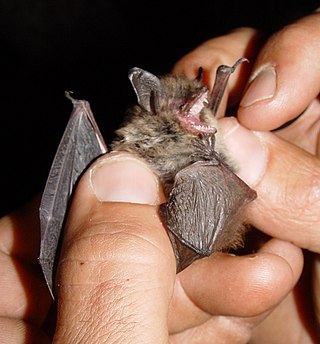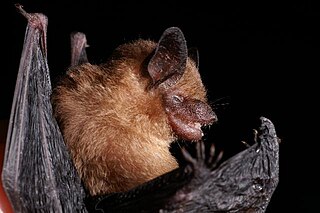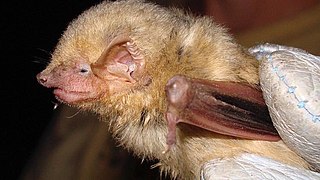
Vespertilionidae is a family of microbats, of the order Chiroptera, flying, insect-eating mammals variously described as the common, vesper, or simple nosed bats. The vespertilionid family is the most diverse and widely distributed of bat families, specialised in many forms to occupy a range of habitats and ecological circumstances, and it is frequently observed or the subject of research. The facial features of the species are often simple, as they mainly rely on vocally emitted echolocation. The tails of the species are enclosed by the lower flight membranes between the legs. Over 300 species are distributed all over the world, on every continent except Antarctica. It owes its name to the genus Vespertilio, which takes its name from a word for bat, vespertilio, derived from the Latin term vesper meaning 'evening'; they are termed "evening bats" and were once referred to as "evening birds".

The mouse-eared bats or myotises are a diverse and widespread genus (Myotis) of bats within the family Vespertilionidae. The noun "myotis" itself is a Neo-Latin construction, from the Greek "muós and "oûs", literally translating to "mouse-eared".

Eptesicus is a genus of bats, commonly called house bats or serotine bats, in the family Vespertilionidae. The genus name is likely derived from the Greek words ptetikos 'able to fly' or petomai 'house flier', although this is not certain.

Murina is a genus of vesper bats. They are found throughout temperate and tropical regions of Asia.
The Javan thick-thumbed bat is a species of vesper bat. It can be found in Indonesia.

The common thick-thumbed bat is a species of vesper bat found in Brunei, Indonesia, Malaysia, Philippines, and Thailand.
Botta's serotine is a species of vesper bat, one of 25 in the genus Eptesicus. It is found in rocky areas and temperate desert.

The lesser bamboo bat or lesser flat-headed bat is one of the smallest species of vesper bat, and is native to Southeast Asia.

The Vespertilioninae are a subfamily of vesper bats from the family Vespertilionidae.

Laephotis is a genus of bats in the family Vespertilionidae. Species within this genus are:

Hesperoptenus is a genus of bats within the Vespertilionidae or vesper bat family.

Rhogeessa is a genus of bats within the vesper bats family, Vespertilionidae.

Nyctophilus is a genus of the vespertilionids or vesper bats. They are often termed Australian big-eared bats or long-eared bats, as the length of their ears often greatly exceeds that of the head. This genus occurs in the New Guinean-Australian region.

Harrison's tube-nosed bat is a species of vesper bats (Vespertilionidae). Within the genus Murina, it belongs to the so-called 'cyclotis-group'.

Thomas's big-eared brown bat is a species of vesper bat found in South America.

Aeorestes is a subgenus of Lasiurus commonly known as the hoary bats.

Dasypterus is a subgenus of Lasiurus. Collectively, members of Lasiurus (Dasypterus) are referred to as the yellow bats.

Glischropus bucephalus, the Indochinese thick-thumbed bat, is a species of bat in the family Vespertilionidae. The bat is found in Cambodia, Myanmar, Laos, Thailand and Vietnam north of the Isthmus of Kra.

Pipistrellini is a tribe of bats in the family Vespertilionidae. It contains several genera found throughout the Old World and Australasia, including the pipistrelles, noctules and related species.

















